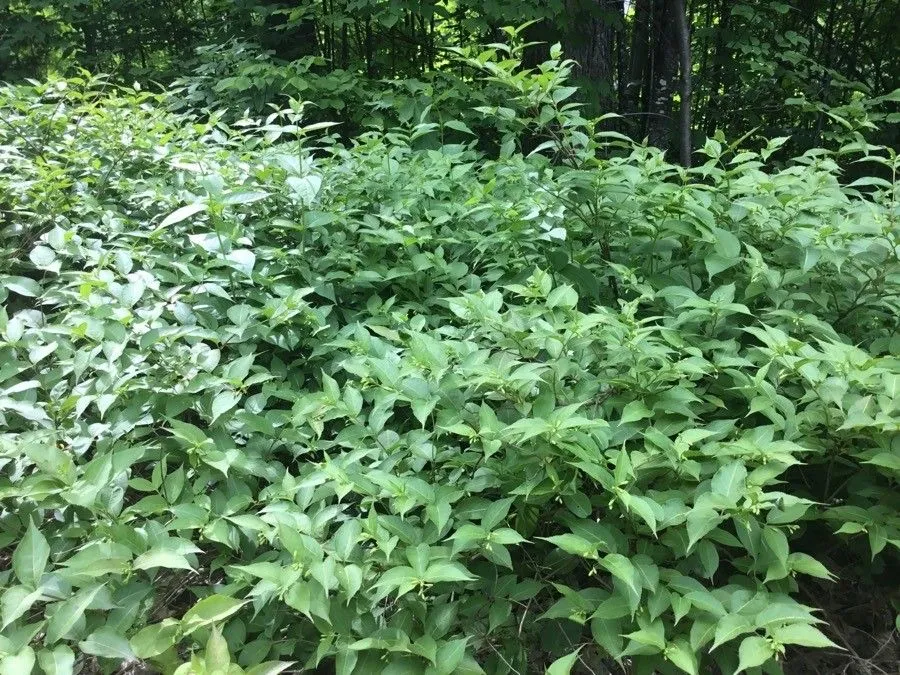
Author: Mill.
Bibliography: Gard. Dict. ed. 8: s.p. (1768)
Year: 1768
Status: accepted
Rank: species
Genus: Diervilla
Vegetable: False
Observations: Subarctic America to NC. & E. U.S.A.
Bush-honeysuckle, known scientifically as Diervilla lonicera, is a resilient and hardy deciduous shrub belonging to the Caprifoliaceae family. It was first described by Mill. in 1768 and remains a favored choice among gardeners and landscapers for its low-maintenance qualities and adaptability to various climates.
Originating from the subarctic regions of America and stretching as far south as North Carolina, Bush-honeysuckle thrives across much of the Eastern United States. Epitomizing the robust and tenacious nature of many native plants, this shrub can endure the harsh climates found within these ranges, making it a superb candidate for naturalizing in a variety of landscapes.
Bush-honeysuckle typically grows to a modest height, making it an excellent option for use as a border plant or for filling in understory layers in larger plantings. Its leaves are lanceolate to ovate, providing a lush green backdrop during the growing season. In addition, this shrub is known for its small, tubular yellow flowers that blossom in late spring to early summer, bringing a subtle charm to gardens.
One of the distinctive characteristics of Diervilla lonicera is its incredible tolerance of different soil types and conditions. It can thrive in poor soils and exhibits a particular resilience to drought once established. This has made it particularly useful in restoration projects and for gardeners seeking low-water landscaping options.
Beyond its ornamental value, Bush-honeysuckle also plays a role in supporting local ecosystems. Its flowers are known to attract pollinators such as bees and butterflies, while birds often seek refuge within its branches. In addition, the shrub’s dense root system helps prevent soil erosion, contributing to the stability of the landscape.
In summary, Bush-honeysuckle (Diervilla lonicera) is a versatile and enduring shrub well-suited to a variety of planting scenarios. Whether used in garden borders, naturalized settings, or ecological restoration projects, it delivers beauty, resilience, and ecological benefits in equal measure.
Eng: bush-honeysuckle, northern bush honeysuckle, northern bush-honeysuckle
Dan: canadisk diervilla, kanadisk klokkebusk
Deu: kanadisches buschgeißblatt
Swe: getris, gulblommigt getris
Ces: zanice zimolezovitá
Nno: diervilla
Nob: diervilla
Fra: dièreville chèvrefeuille, herbe bleue
En: Bush-honeysuckle, Northern bush honeysuckle, Northern bush-honeysuckle
Cs: Zanice zimolezovitá
Da: Canadisk diervilla, Kanadisk klokkebusk
Fr: Dièreville chèvrefeuille, Herbe bleue
De: Kanadisches Buschgeißblatt
Nb: Diervilla
Nn: Diervilla
Sv: Getris, Gulblommigt getris
Taken Jan 2, 2021 by Lily Jones (cc-by-sa)
Taken Jul 20, 2021 by Emily Moylan (cc-by-sa)
Taken Sep 16, 2021 by Patrick M (cc-by-sa)
Taken May 18, 2021 by jenyfer Renaud (cc-by-sa)
Taken Jul 20, 2021 by Duc Lam (cc-by-sa)
Taken Jun 24, 2021 by pat brown (cc-by-sa)
Taken Jul 1, 2020 by Rioux Régis (cc-by-sa)
Taken Jul 18, 2019 by Bob Arnold (cc-by-sa)
Taken Jul 22, 2021 by Marina Dimitriadis (cc-by-sa)
Taken Mar 4, 2011 by EOL − Ken-ichi Ueda (cc-by-nc-sa)
Taken Sep 13, 2022 by Rob Stavinga (cc-by-sa)
Taken Jun 20, 2019 by Cor Maatje (cc-by-sa)
Taken Jan 2, 2021 by Lily Jones (cc-by-sa)
Taken Jun 30, 2015 by EOL − Killarney Provincial Park (cc-by-nc)
Taken Jun 17, 2014 by EOL − dlacey (cc-by-nc)
Taken Jun 19, 2014 by EOL − Robert L Curtis (cc-by-nc-sa)
Taken Jun 28, 2015 by EOL − Charlie Hohn (cc-by-nc)
Taken Jun 5, 2021 by France Loiselle (cc-by-sa)
Taken Aug 23, 2022 by Renée-Louise Lamontagne (cc-by-sa)
Taken Jun 9, 2021 by Yvonne Pandke (cc-by-sa)
Taken Oct 13, 2019 by morgan morgan hancock (cc-by-sa)
Taken Oct 13, 2019 by morgan morgan hancock (cc-by-sa)
Taken Oct 15, 2018 by Cherokee Twin (cc-by-sa)
Taken May 18, 2019 by Kelli Strong (cc-by-sa)
Taken Jul 22, 2020 by Valerie Hollett (cc-by-sa)
Taken Feb 19, 2013 by EOL − evening (cc-by-nc)
Growth form: Multiple Stem
Growth habit: Shrub
Growth rate: Slow
Ph maximum: 7.0
Ph minimum: 4.8
Family: Myrtaceae Author: (F.Muell.) K.D.Hill & L.A.S.Johnson Bibliography: Telopea 6: 402 (1995) Year: 1995 Status:…
Family: Rubiaceae Author: Pierre ex A.Froehner Bibliography: Notizbl. Bot. Gart. Berlin-Dahlem 1: 237 (1897) Year:…
Family: Sapindaceae Author: Koidz. Bibliography: J. Coll. Sci. Imp. Univ. Tokyo 32(1): 38 (1911) Year:…
Family: Asteraceae Author: A.Gray Bibliography: Pacif. Railr. Rep.: 107 (1857) Year: 1857 Status: accepted Rank:…
Family: Fabaceae Author: Medik. Bibliography: Vorles. Churpfälz. Phys.-Ökon. Ges. 2: 398 (1787) Year: 1787 Status:…
Family: Aspleniaceae Author: (Cav.) Alston Bibliography: Bull. Misc. Inform. Kew 1932: 309 (1932) Year: 1932…